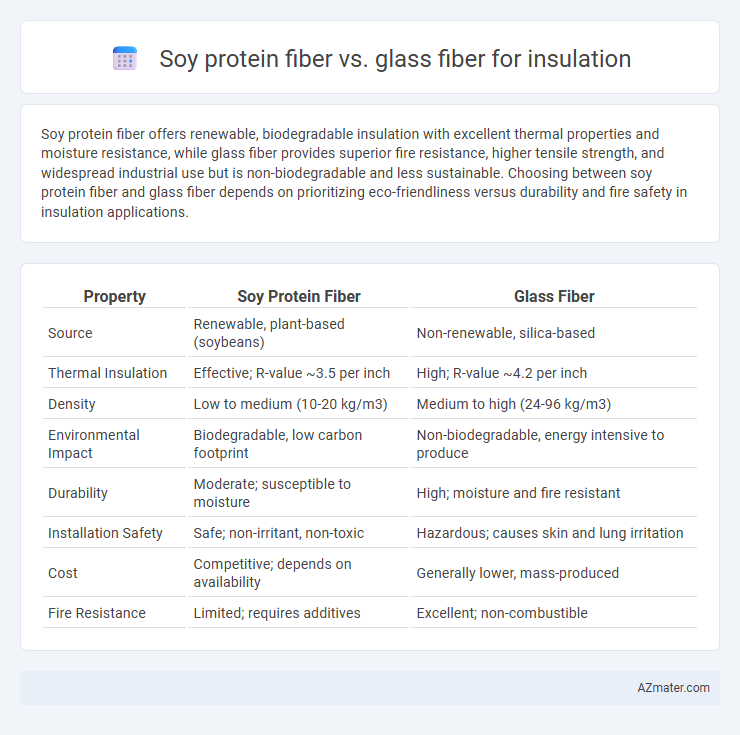Soy protein fiber offers renewable, biodegradable insulation with excellent thermal properties and moisture resistance, while glass fiber provides superior fire resistance, higher tensile strength, and widespread industrial use but is non-biodegradable and less sustainable. Choosing between soy protein fiber and glass fiber depends on prioritizing eco-friendliness versus durability and fire safety in insulation applications.
Table of Comparison
| Property | Soy Protein Fiber | Glass Fiber |
|---|---|---|
| Source | Renewable, plant-based (soybeans) | Non-renewable, silica-based |
| Thermal Insulation | Effective; R-value ~3.5 per inch | High; R-value ~4.2 per inch |
| Density | Low to medium (10-20 kg/m3) | Medium to high (24-96 kg/m3) |
| Environmental Impact | Biodegradable, low carbon footprint | Non-biodegradable, energy intensive to produce |
| Durability | Moderate; susceptible to moisture | High; moisture and fire resistant |
| Installation Safety | Safe; non-irritant, non-toxic | Hazardous; causes skin and lung irritation |
| Cost | Competitive; depends on availability | Generally lower, mass-produced |
| Fire Resistance | Limited; requires additives | Excellent; non-combustible |
Introduction to Insulation Materials
Soy protein fiber offers renewable and biodegradable properties as an insulation material derived from natural sources, enhancing environmental sustainability. Glass fiber insulation, made from fine strands of glass, provides high thermal resistance and durability, widely used in construction for its fire resistance and soundproofing capabilities. Both materials contribute significantly to energy efficiency, with soy protein fiber emphasizing eco-friendliness and glass fiber focusing on performance and longevity.
Overview of Soy Protein Fiber
Soy protein fiber, derived from renewable soybeans, offers excellent thermal insulation properties combined with natural biodegradability, making it an eco-friendly alternative to traditional fibers. It provides effective moisture regulation and sound absorption while maintaining durability and resistance to mold and pests, ideal for sustainable building applications. Compared to glass fiber, soy protein fiber reduces health hazards during installation and disposal, enhancing indoor air quality and environmental safety.
Overview of Glass Fiber
Glass fiber insulation consists of fine strands of glass woven into mats or loose-fill forms, providing excellent thermal resistance and fire retardant properties. It boasts high durability, moisture resistance, and soundproofing capabilities, making it a popular choice for walls, attics, and HVAC systems. Compared to soy protein fiber insulation, glass fiber offers superior structural integrity and long-term performance in a wide range of temperature conditions.
Thermal Insulation Properties Comparison
Soy protein fiber insulation typically exhibits lower thermal conductivity values ranging between 0.035 to 0.040 W/m*K, providing effective thermal resistance and energy efficiency in building applications. Glass fiber insulation generally offers superior thermal insulation performance with conductivity values around 0.025 to 0.035 W/m*K, allowing for thinner insulation layers while maintaining high thermal resistance. The choice between soy protein and glass fiber depends on specific project requirements, balancing eco-friendliness against maximum thermal performance.
Environmental Impact and Sustainability
Soy protein fiber insulation boasts a significantly lower carbon footprint compared to glass fiber, as it is derived from renewable agricultural byproducts and is biodegradable. Glass fiber production relies on high-temperature processes that consume more energy and generate substantial greenhouse gas emissions, while soy protein fibers offer enhanced thermal performance with minimal environmental detriment. The sustainable sourcing and end-of-life compostability of soy protein fiber make it a superior eco-friendly choice for insulation applications.
Health and Safety Considerations
Soy protein fiber insulation offers non-toxic, biodegradable properties with minimal respiratory irritants, making it safer for indoor air quality compared to glass fiber, which can release respirable glass particles posing health risks such as skin irritation and respiratory issues. The natural composition of soy protein fiber reduces the need for chemical binders, lowering exposure to volatile organic compounds (VOCs) often associated with conventional glass fiber products. Proper handling and protective equipment remain essential for both materials, but soy protein fiber insulation generally provides a healthier and more environmentally friendly alternative for indoor insulation applications.
Cost Analysis: Soy Protein vs Glass Fiber
Soy protein fiber insulation offers a competitive cost advantage over glass fiber due to its renewable material source and lower energy-intensive manufacturing process, reducing overall production expenses. In comparison, glass fiber insulation requires higher raw material and energy input, increasing initial costs and impacting long-term cost efficiency. When evaluating insulation options, soy protein fiber can provide cost savings while also supporting sustainability goals.
Installation and Handling Differences
Soy protein fiber insulation offers a lightweight and flexible material that simplifies cutting and fitting around irregular spaces, reducing installation time and labor costs. Glass fiber insulation, while more rigid and denser, requires protective gear during handling to avoid skin irritation and respiratory issues, often complicating the installation process. The soybean-based fiber's biodegradability and reduced dust production make it a safer and more user-friendly option compared to the synthetic, scratch-prone glass fiber.
Durability and Longevity
Soy protein fiber insulation offers excellent durability with natural resistance to mold and pests, ensuring a longer lifespan in moderate conditions. Glass fiber insulation provides superior longevity due to its non-organic composition, which resists moisture, fire, and degradation over time. The choice between soy protein fiber and glass fiber for insulation ultimately depends on environmental exposure and desired maintenance requirements.
Future Trends in Insulation Materials
Soy protein fiber insulation offers sustainable, biodegradable properties and enhanced moisture regulation, making it a promising alternative to traditional glass fiber. Future trends indicate increased demand for eco-friendly insulation materials driven by stricter environmental regulations and consumer preference for renewable resources. Advances in bio-based composite technologies will likely improve the thermal performance and durability of soy protein fiber, positioning it as a competitive solution in next-generation insulation markets.

Infographic: Soy protein fiber vs Glass fiber for Insulation
 azmater.com
azmater.com